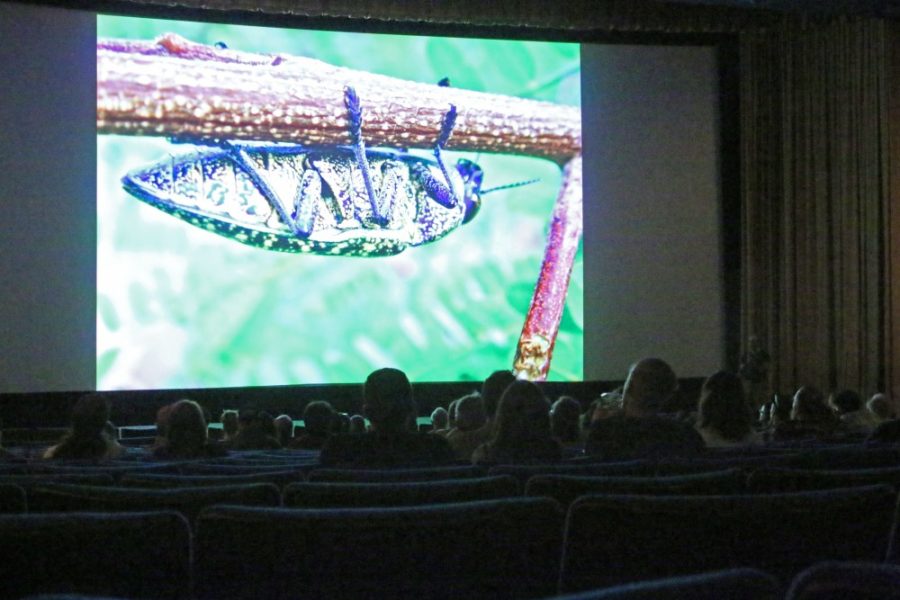“Mad Max: Fury Road,” the fourth installment in the Mad Max franchise that began with Mel Gibson as the title character in 1979, unleashed its wrath on the big screen at The Loft Cinema on Wednesday night as part of the cinema’s Science on Screen series.
Prior to the film, wildlife biologist and ethnobotanist Vincent Pinto gave a talk about the environment and what we can do to avoid, and survive, a world like that of “Mad Max.”
“I try to inspire people to save the Earth, to practice conservation,” Pinto said. “[In] conjunction with ‘Mad Max: Fury Road’ tonight, I hope to inspire people not to go there, actually—to avoid an apocalypse and the end of the world, so to speak, and to do everyday practices that will lead to that end.”
RELATED: The Loft Cinema to host ‘Science on Screen’ event
Some of the things Pinto mentioned in order to avoid a “Mad Max” world, as well as survive, included supplying a good environmental education to people, land stewardship, native landscaping, wildlife habitat restoration, water conservation, learning survival skills before you need them and connecting to the land and letting life own you.
Pinto revealed a new way of perceiving “Mad Max,” saying that it may be an example of “art presaging reality,” or basically a preview of what could happen should we let things get out of hand.
“Mad Max: Fury Road” follows survivor Max Rockatansky, played by Tom Hardy in the 2015 film, in a postapocalyptic world. Max is captured by the War Boys, an army led by the totalitarian Immortan Joe, played by Hugh Keays-Byrne.
In a series of events, Max reluctantly finds himself helping Imperator Furiosa, played by Charlize Theron, in escaping with Immortan Joe’s selected “breeders” to the “Green Place,” a serene land Furiosa recalls from her childhood.
The title, Fury Road, comes into play as they fight their way, driving odd and exciting contraptions; Furiosa’s “War Rig” is perhaps the most prominent mode of transportation noted in the film.
“Mad Max” has long been a popular franchise, and the showing of the newest installment at The Loft attracted fans.
Scott Blaney, an architect, was among those in attendance Wednesday night.
“We came partly because of the movie that we like and partly because we heard the speaker tonight was a specialist and the future of the world and what happens at the end of the world to survive it,” Blaney said.
Maralee Whitey, a global studies sophomore, said she came to the event because she likes the “Mad Max” movie and she has been wanting to check out The Loft.
“I’m looking forward to the talk afterwards, as well, just because it seems interesting. And who doesn’t want to learn about surviving?” Whitey said.
RELATED: ’Big Trouble’ at the Loft Cinema brings together Tucson fans
In attending the showing, people were both educated and entertained. “Mad Max” is a more extreme version of a post-apocalyptic reality that portrays the downfall of humanity and its environment but nonetheless conveys the importance and necessity of caring for the Earth and its inhabitants in the film’s overall message.
For Keegan Blackburn, an architecture sophomore, the “Mad Max” showing offered a respite for an upcoming final project, as well as a chance to hang out with friends.
“I also very much like the visual aspects in the film,” Blackburn said. “I just wanted to hang out with my friends and watch a movie that I know that I like seeing and to see that with them for the first time. Movies are best when you can enjoy them with people that you enjoy being with.”
In any case, “Mad Max” offered something different from the everyday routine. The film was nominated for 10 Academy Awards; it won six of these, one of which was for best achievement in production design.
The event also offered wilderness survival knowledge. To be a survivor, you must possess particular qualities. For those that couldn’t attend, here’s a quick recount to fill you in:
A survivor is knowledgeable and skilled, as well as mentally and physically prepared. They are well-equipped or able to use the resources at hand. They never ask “Why me?” and they are alert and adaptable.
Perhaps the two most important things survivors can do is be able to laugh at themselves and their situation and, despite everything, never quit.
Follow Kacie Lillejord on Twitter.









